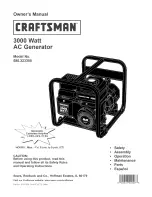
3
VAC-SIF-05
Training & Maintenance Manual
CVX0260B
Parker Hannifin Corporation
Pneumatic Division
Richland, Michigan
www.parker.com/pneumatic
Sensor Output Function
Sensor outputs are open collector transistor type.
Replacement Sensor MPS-V23C-NC is an NPN Sinking
Sensor. When installed on the CVX0260B, the onboard
electronics converts this sensor to a PNP circuit. Wiring
circuit of the CVX0260B units is PNP, Sourcing. Each
vacuum generator sensor has 2 outputs. Output 1 and
Output 2 are independent of each other and have different
factory set conditions. These settings can be changed with
the touch pad programming.
Definitions
Switch Point
Setting on the pressure sensor that changes a sensor output
status when a specific pressure is obtained in the vacuum
system.
n_1 Switch Point of Output 1 of the pressure sensor.
This output controls the air Economizing functions.
P_3 Switch Point of Output 2 of the pressure sensor.
This output controls the part presence signal.
Hysteresis Range
This setting is the actual reversing point.
n_2 Reverse Set Point of Output 1 of the pressure
sensor. This value sets the reversing point
of output 1 Switch Point for Air Economizing.
P_4 Reverse Set Point of Output 2 of the pressure
sensor. This value sets the reversing point
of output 2 Switch Point for Part Presence.
Hysteresis Mode
Provides one switch point (n_1 or P_3) and a reverse point
(n_2 or P_4) per output of the sensor. When the switch point
pressure is achieved, the output is activated or deactivated.
Air Economizing
Minimizes air consumption by utilizing the built in check
valve. Once a predetermined vacuum level has been
achieved (n_1), the vacuum pilot operated valve is turned
off and the check valve maintains the vacuum level within
the system. The vacuum operated pilot valve is turned back
on at a vacuum level n_2. The hysteresis feature of the
vacuum sensor can maintain the vacuum level of the system
indefinitely when properly wired to the vacuum solenoid pilot
valve and operating pressure and PLC Vacuum ON signal is
present.
Sensor Output 1 - Air Economizing
This sensor output does not interface with the Input table of
the PLC/PC. This sensor output interfaces with the Output
table of the PLC/PC for the vacuum control signal. The
Vacuum Pilot Valve Solenoid is connected to the PLC/PC
output table through Sensor Output 1.
The switch point setting (n_1) on output 1 of the sensor
activates the on/off air economizing levels. The sensor output
is connected to the vacuum pilot valve via the electrical
enclosure for each of the channels. No external PLC
programming is required for Air Economizing Functions
because this function is built into the electrical unit. When
the vacuum level in system achieves the preset valve of
n_1, the sensor output switches to an Open, Non-passing,
state. This deactivates the vacuum pilot valve. In nonporous
applications, the internal check valve maintains the vacuum
level till the level drops to the reverse point setting vacuum
n_2. At this point, the sensor output switches to a closed
position, passing state and activates the vacuum pilot valve.
This cycle will continue depending on the vacuum system.
Sensor Output 2 - Vacuum Confirmation – Part
Presence Signal
Operates as an Output from the Sensor to provide a Part
Presence Signal. This sensor output interfaces with the Input
table on the PLC/PC. When the cup is adhered to the part,
vacuum level increases and at the Switch Point Setting
(P_3), the sensor changes state to indicate a part presence
Signal.
PSI
inHg
ON
OFF
ON
OFF
Vacuum
Solenoid
Sensor
Output 1
ON
OFF
ON
OFF
Blow-Off
Solenoid
Compressed
Air Savings
(n_1)
(P_3)
(P_4)
(n_2)
Description & Operation




































